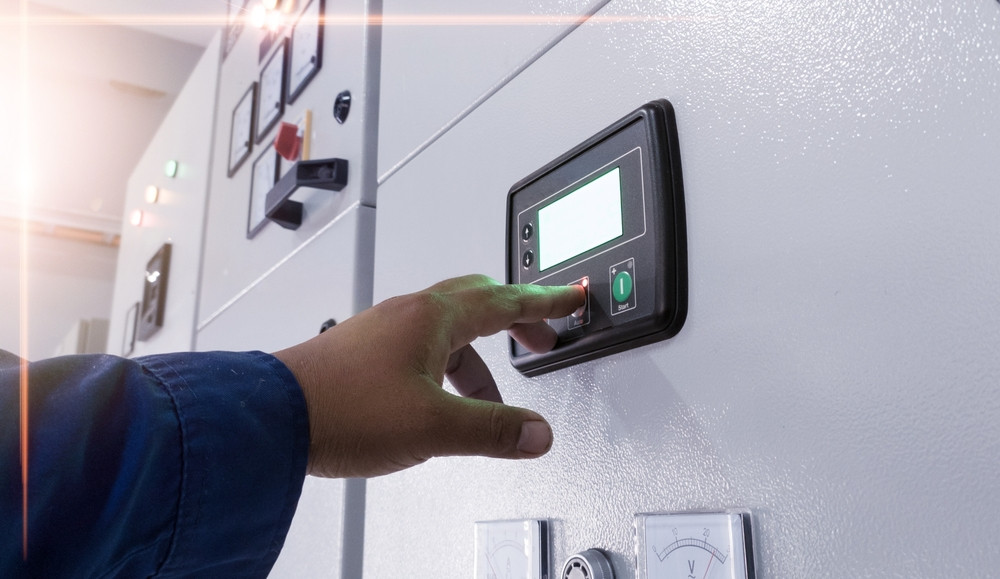Power flickers in a high-rise last for only a second, yet that single second can strand an elevator between floors, lock guests out of their rooms, and bring a data closet to its knees.
Tenants call, alarms blare, and every eye turns to the building team for answers. Facility leaders know their reputations, and their lease renewals, rely on keeping electricity steady even when the grid stumbles.
That reality drives a deceptively simple question: should you protect the building with an uninterruptible power supply (UPS), a standby generator, or both? The answer can’t rely on rules of thumb.
Each asset responds on a different timeline, supports different loads, and carries different maintenance obligations. Choose the wrong one and you risk costly downtime or compliance violations. Choose wisely and you win priceless peace of mind.
This guide breaks down the practical differences so property managers and superintendents can match the right solution to their specific risk window, budget, and code requirements.
It also highlights where licensed electrical engineers, like the team at MTA Electrical Engineers, add value with short-circuit studies, arc flash analysis, and coordination testing that keep both systems working in harmony.
Why Response Time Dictates Everything
Milliseconds keep passengers safe. A double-conversion UPS detects a utility sag and shifts to battery power in under twelve milliseconds. That near-instant reaction is fast enough to prevent drives, PLCs, and elevator controllers from ever “seeing” the event.
Seconds matter for life safety. A generator equipped with an automatic transfer switch needs time to sense the outage, spin up to rated speed, and sync voltage. NFPA 110 Type 10 systems must do this in under ten seconds, which satisfies most fire-pump and emergency-lighting requirements but is too slow for sensitive electronics.
Minutes become hours. Battery strings inside a UPS are sized for ten to twenty minutes at full load, just enough to ride through grid blips or hand the baton to a generator. Diesel or natural-gas generators, on the other hand, can run for days provided there is fuel and cooling.
Mapping these timelines to the building’s risk profile usually clarifies which technology leads the race. Critical-process manufacturers may tolerate a three-second gap on production lines but refuse any dip on process controllers. Mixed-use towers need elevators to level passengers safely within a second and keep life-safety circuits alive until the generator holds the load.
How a UPS Brings Instantaneous Protection
A commercial-grade UPS does more than act as a big battery. Its rectifier converts incoming AC to DC, charges the battery string, then an inverter creates a new, clean sine wave. That double-conversion isolates downstream equipment from voltage dips, swells, and harmonics, risks that a generator alone cannot eliminate.
Common UPS topologies
- Online (double-conversion): Full isolation and zero transfer time. Ideal for elevators, security servers, and building automation.
- Line-interactive: Budget-friendly compromise that conditions power with an autotransformer, yet still switches to battery in a few milliseconds.
- Standby: Basic units that keep the inverter off until an outage; rarely appropriate for commercial facilities.
Licensed electrical engineers size UPS units after running a short-circuit study to confirm interrupting ratings and a coordination study to set breaker trip points. These analyses prevent nuisance shutdowns and keep arc flash levels within tolerable limits once batteries discharge high fault currents.
Best loads for a UPS
- Elevators and traction rescue devices that need a short burst to reach the nearest floor.
- Card-access, CCTV, and intrusion systems where even a one-second blackout resets clocks or drops recordings.
- Building automation servers controlling HVAC, fire dampers, and energy meters.
Retail POS terminals or data closets that must write cache to disk before a longer outage.
Maintenance obligations
Keeping a UPS healthy means:
- Monthly visual inspections for swelling or leakage.
- Semi-annual battery impedance testing per IEEE 1188.
- Infrared scans of DC bus bars and breaker studs.
- Replacing valve-regulated lead-acid batteries every five to seven years, or lithium packs per manufacturer guidance.
MTA Electrical Engineers frequently pairs these inspections with annual arc flash analysis updates so that new labels reflect battery fault contributions. Regulators are paying closer attention to this requirement, and fines for outdated labeling are growing.
Cost and Footprint Considerations
UPS cabinets scale economically up to roughly 300 kW. Beyond that point the cost per kilowatt climbs sharply because larger battery banks, cooling, and floor loading drive complexity. Space-constrained downtown buildings often favor a 150 kVA unit supporting life-safety and IT loads, while a rooftop generator handles HVAC and lighting during prolonged outages.
Fuel-free operation is another selling point. A UPS draws and stores utility power, so there is no on-site diesel permitting or annual emissions testing. That said, the battery replacement cycle must be budgeted just as seriously as a generator’s fuel delivery contract.
Where a Generator Takes the Lead
Few assets inspire more confidence during a blackout than a properly sized standby generator. Once the automatic transfer switch senses utility failure, the engine starts, exciter builds voltage, and breakers close on a fresh, stable power source. The process usually finishes within ten seconds, fast enough to meet code requirements for fire pumps, smoke control fans, and emergency lighting.
Ideal loads for a generator
- HVAC chillers and rooftop units that would overwhelm a battery bank in minutes.
- Production lines and commercial kitchens where extended shutdowns translate directly to lost revenue.
Life-safety circuits that must operate for the entire duration of an outage rather than a brief bridge period.
Sizing a generator isn’t guesswork. An electrical engineer conducts a load study, accounts for motor starting currents, checks local emissions limits, and then verifies fault current contributions through a short-circuit analysis. Skipping these steps can leave breakers mis-coordinated and feeders exposed to dangerous arc flash energy levels.
Maintenance requirements
- Weekly or monthly no-load exercise runs to keep fluids circulated.
- Annual load-bank testing to confirm the unit can carry its nameplate rating.
- Fuel testing and polishing for diesel systems, or pressure checks for natural gas feeds.
- Quarterly inspection of exhaust, cooling, and control systems.
These tasks cost more than UPS maintenance yet pay dividends when the grid stays down for hours. MTA Electrical Engineers frequently bundles generator testing with arc flash label updates and coordination studies, creating a single compliance report that simplifies audits.
UPS + Generator: Layering Defense
A UPS and a generator are not competitors. They solve different parts of the same reliability puzzle. The UPS supplies immediate, high-quality power, shielding electronics from the slightest flicker. The generator delivers the stamina required for long outages.
Together they create an uninterrupted bridge from the first millisecond through the final minute of a multi-day blackout.
Key integration points:
- Transfer timing. The automatic transfer switch must sense stable generator voltage before shifting UPS input. Too early and the UPS may ride through on battery longer than planned.
- Harmonic tolerance. Double-conversion UPS units can impose nonlinear loads on smaller generators. Harmonic studies allow engineers to specify filters or adjust inverter settings, protecting alternator windings and voltage regulators.
- Selective coordination. Breaker settings need to isolate downstream faults without dropping the entire building. Coordination studies ensure the UPS, transfer switch, and generator breakers trip in the proper sequence.
Decision Matrix: Choosing the Right Backup Mix
| Scenario | UPS only | Generator only | Hybrid |
| Professional office with critical IT but modest HVAC loads | ✓ | ✓ | |
| High-rise residential tower with elevators and fire pumps | ✓ | ✓ | |
| Cold-storage warehouse guarding perishable inventory | ✓ | ✓ | |
| Manufacturing plant with sensitive controls and large motors | ✓ |
Start with the building’s tolerance for a power gap. If any circuit must remain energized from the first millisecond, a UPS is mandatory. If outage length could exceed fifteen minutes, a generator becomes non-negotiable. Most large facilities discover that combining both delivers the lowest overall risk.
Lifecycle Costs and Maintenance Realities
- Capital expense. Small to mid-size UPS systems start near $350 per kilowatt. Large diesel generators often land closer to $250 per kilowatt once switchgear and fuel storage are included.
- Operating expense. Expect battery replacement every five to seven years at roughly 25 percent of initial UPS cost. Generators burn fuel, require oil changes, and need licensed technicians for annual load-bank tests.
- Space and permitting. UPS cabinets live indoors and do not require air quality permits. Generators need outdoor pads, sound attenuation, and local environmental approvals, especially in dense urban corridors.
Our engineers at MTAEE weigh these variables through life-cycle cost analysis software, letting owners compare twenty-year net present values rather than focusing solely on first cost.
Compliance Traps to Avoid
- Underrated transfer switch. Failing to account for generator fault current can leave a switch incapable of closing on load, a violation that insurance carriers red-flag.
Out-of-date arc flash study. Adding a generator changes available fault current and clearing times, altering personal protective equipment boundaries. - Neglected battery testing. Dead cells inside a UPS often stay hidden until the day they are needed most. IEEE impedance testing reveals declining capacity early, but only if scheduled.
- Each trap highlights why project teams lean on electrical engineers rather than general contractors for backup-power projects. Proper studies eliminate guesswork and produce documentation that satisfies inspectors and insurers alike.
Closing Thoughts
Short outages demand instant power. Long outages demand endurance. A UPS covers the first, a generator covers the second, and together they protect people, property, and revenue through every phase of a blackout. Selecting, sizing, and integrating these assets is a technical exercise that rewards precision. At MTA Electrical Engineers, we've spent decades guiding commercial and industrial clients throughout California and the broader West Coast. Our team performs electrical system testing, short-circuit studies, arc flash analysis, and coordination studies. When you are ready to lock down uninterrupted operations, reach out to our engineers.

